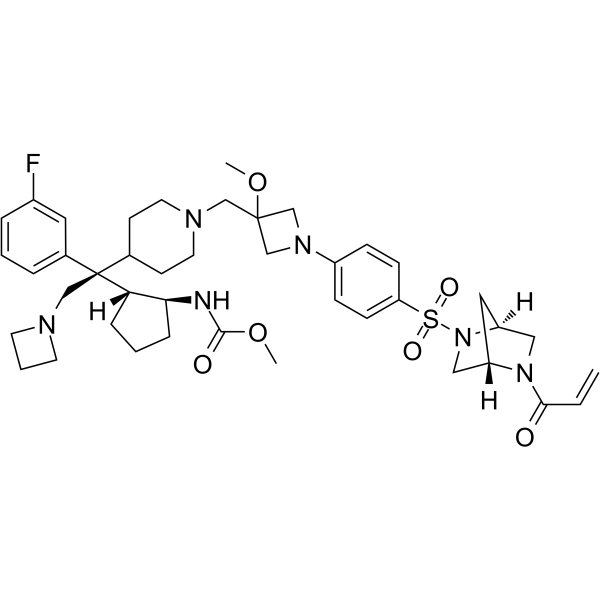| Description |
M‑1121 is a covalent and orally active inhibitor of the menin-MLL interaction capable of achieving complete and persistent tumor regression[1].
|
| Related Catalog |
|
| Target |
menin-MLL interaction[1]
|
| In Vitro |
M-1121 (0~100 nM; 24 hours; MV4;11 cells) drives dose-dependent down-regulation of HOXA9 and MEIS1 gene expression in the MLL-rearranged MV4;11 leukemia cell line[1]. M-1121 establishes covalent interactions with Cysteine 329 located in the MLL binding pocket of menin and potently inhibits growth of acute leukemia cell lines carrying MLL translocations with no activity in cell lines with wild-type MLL[1]. RT-PCR[1] Cell Line: MV4;11 cells Concentration: 0~100 nM Incubation Time: 24 hours Result: Drived dose-dependent down-regulation of HOXA9 and MEIS1 gene expression in the MLL-rearranged MV4;11 leukemia cell line.
|
| In Vivo |
M-1121 (100 mg/kg; p.o.; 26 days) reduces the average tumor volume from 157 mm3 at the beginning of the treatment to 106 mm3 on day 26 of the treatment, a reduction of tumor volume of 32%[1]. M-1121 (300 mg/kg; p.o.) leads to complete tumor regression in 10 out of 10 mice with no tumor regrowth detected up to a month after last treatment[1]. M-1121 (5 mg/kg; p.o.) has a low clearance and a moderate volume of distribution[1]. Animal Model: SCID mice[1] Dosage: 100 mg/kg Administration: P.o. Result: Reduced the average tumor volume from 157 mm3 at the beginning of the treatment to 106 mm3 on day 26 of the treatment, a reduction of tumor volume of 32%. Animal Model: SCID mice[1] Dosage: 300 mg/kg Administration: P.o. Result: Led to complete tumor regression in 10 out of 10 mice with no tumor regrowth detected up to a month after last treatment. Animal Model: Female C57BL/6 mice[1] Dosage: 5 mg/kg (Pharmacokinetic Analysis) Administration: P.o. Result: Had a low clearance and a moderate volume of distribution.
|
| References |
[1]. Zhang M, et al. Discovery of M-1121 as an Orally Active Covalent Inhibitor of Menin-MLL Interaction Capable of Achieving Complete and Long-Lasting Tumor Regression. J Med Chem. 2021;64(14):10333-10349.
|
